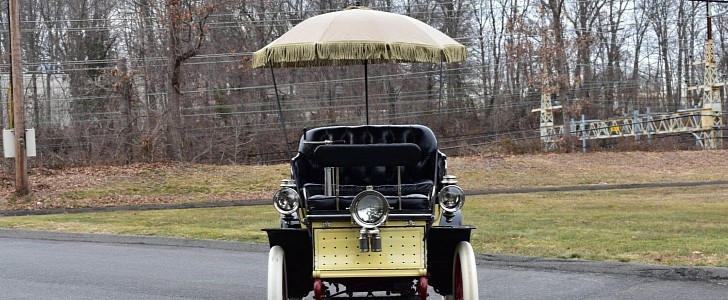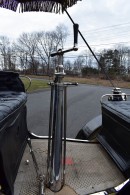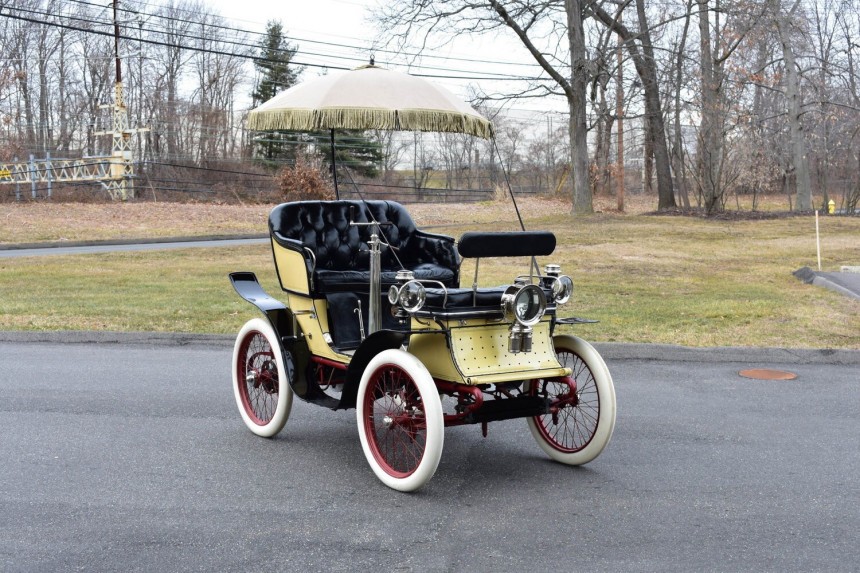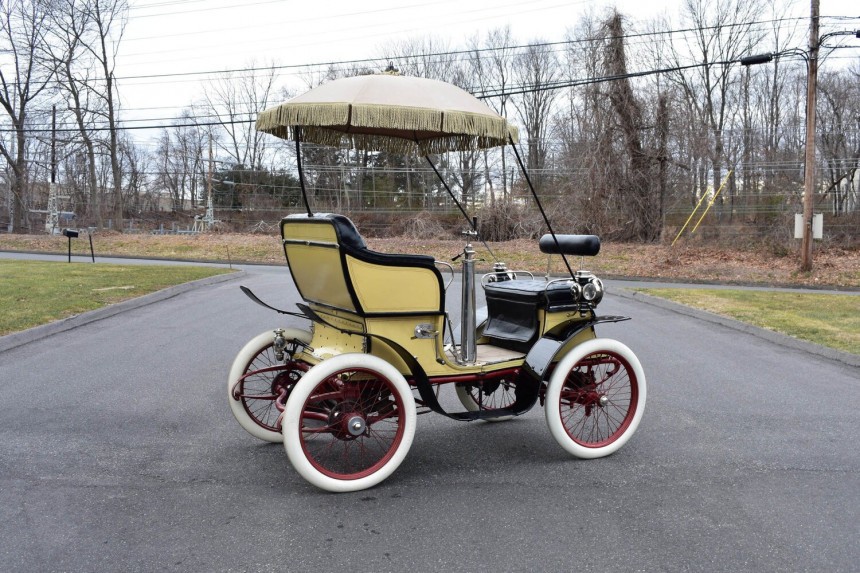We can forgive antique cars for looking a little bit goofy, but there’s a fine line between goofy and downright ridiculous that this 1901 DeDion Boutton doesn’t bother even slightly to navigate.
The bottom portion of this horseless carriage is a pretty standard affair. Still, good lord, whoever designed the roof arrangements must have been high off whatever substance the US government hadn’t gotten around to making illegal yet.
DeDion Bouton was a French automaker whose ingenuity hit its peak when the industry was still in its infancy The moniker began life in the early 1880s in a Frech town in the Parisian suburbs called Puteaux. Marquis Jules-Albert de Dion, Georges Bouton, and Bouton's brother-in-law Charles Trépardoux established the company in 1883. The Bouton entrepreneurs were toy producers, and Jules-Albert de Dion was a wealthy man with a vision who designed a steam-powered car in 1881 and was eager to see his idea spread around the world.
Initially, their business was primarily in the rail industry. But by the tail end of the decade, their automotive division was the largest horseless carriage manufacturer in the world, the General Motors analog of the turn of the 20th century. The firm grew so large that it had to go on to make a business move that wouldn't become standard practice in the industry until almost a century later: they built a factory in a foreign nation, in New York City, of all places.
De Dion Buton factory opened at 37th Street and Church Avenue in Brooklyn in 1901. Unfortunately, it produced only one model, named Mottorette. Its success was limited, and the company managed to sell only a small number of them. Just a few of them survived to these days.
The DeDion Bouton models made in the Brooklyn factory were most often two-seater vis-a-vis designs. An arrangement where the passengers sit face to face with the front passengers facing rearward and the rear occupants facing the front. It sported a three and a half horsepower engine of an unknown displacement. Those measurements weren’t standardized until almost two decades later.
The quality of these manufactured cars was low since everything was done by hand with unskilled workers. That led to poor reliability, and the American episode of the French carmaker ended after only a year. This means only a small number of vehicles ever left their factory, and even fewer still survive today. The company itself would last for four decades more but came to a halt after the start of the Second World War.
Even with the cartoonish roof, this is a nugget of American automotive history that very well could have been lost to history. It's somewhat of a miracle some of them made it to 2021 in one piece, after 120 years since it left the factory. It even featured a form of headlamp with oxyacetylene gas, which helped the driver see the roads ahead. On the plus side, it worked even with the engine shut off since it didn't need electricity.
The black leather seats look comfortable enough to take a nap on, which is good because the tiller steering arrangement borrowed from boats looks far too terrifying to operate. Because the car had no key, the prospects of even starting the thing up would probably be too difficult a task for most people.
In November 1982, Honda opened the first wholly foreign owned American car manufacturing plant in America since Dedion's Brooklyn factory closed its doors forever. Unlike the French attempt at an American factory, the Accord that was made at the Marysville, Ohio facility would go on to become one of the best selling cars not just in America, but the world. With this move, the American auto industry was chanegd forever, and in doing so proved old man DeDion and his collegue's ambitions of dominating the American market from abroad were achievable.
DeDion Bouton was a French automaker whose ingenuity hit its peak when the industry was still in its infancy The moniker began life in the early 1880s in a Frech town in the Parisian suburbs called Puteaux. Marquis Jules-Albert de Dion, Georges Bouton, and Bouton's brother-in-law Charles Trépardoux established the company in 1883. The Bouton entrepreneurs were toy producers, and Jules-Albert de Dion was a wealthy man with a vision who designed a steam-powered car in 1881 and was eager to see his idea spread around the world.
Initially, their business was primarily in the rail industry. But by the tail end of the decade, their automotive division was the largest horseless carriage manufacturer in the world, the General Motors analog of the turn of the 20th century. The firm grew so large that it had to go on to make a business move that wouldn't become standard practice in the industry until almost a century later: they built a factory in a foreign nation, in New York City, of all places.
De Dion Buton factory opened at 37th Street and Church Avenue in Brooklyn in 1901. Unfortunately, it produced only one model, named Mottorette. Its success was limited, and the company managed to sell only a small number of them. Just a few of them survived to these days.
The quality of these manufactured cars was low since everything was done by hand with unskilled workers. That led to poor reliability, and the American episode of the French carmaker ended after only a year. This means only a small number of vehicles ever left their factory, and even fewer still survive today. The company itself would last for four decades more but came to a halt after the start of the Second World War.
Even with the cartoonish roof, this is a nugget of American automotive history that very well could have been lost to history. It's somewhat of a miracle some of them made it to 2021 in one piece, after 120 years since it left the factory. It even featured a form of headlamp with oxyacetylene gas, which helped the driver see the roads ahead. On the plus side, it worked even with the engine shut off since it didn't need electricity.
The black leather seats look comfortable enough to take a nap on, which is good because the tiller steering arrangement borrowed from boats looks far too terrifying to operate. Because the car had no key, the prospects of even starting the thing up would probably be too difficult a task for most people.




















